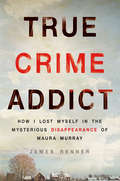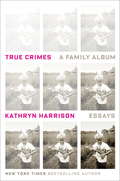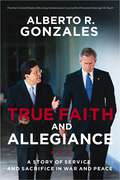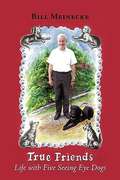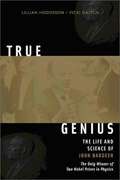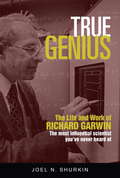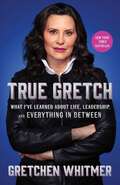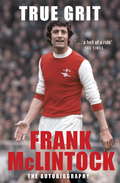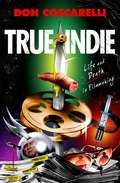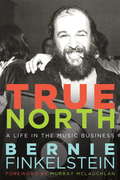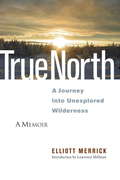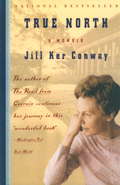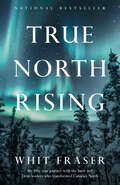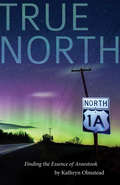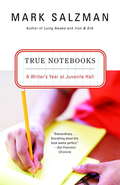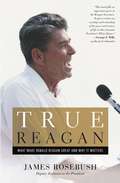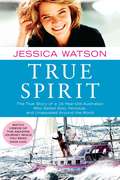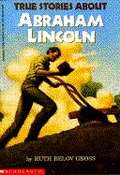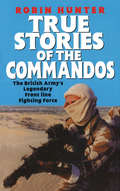- Table View
- List View
True Crime Addict: How I Lost Myself in the Mysterious Disappearance of Maura Murray
by James RennerWhen an eleven year old James Renner fell in love with Amy Mihaljevic, the missing girl seen on posters all over his neighborhood, it was the beginning of a lifelong obsession with true crime. That obsession leads James to a successful career as an investigative journalist. It also gave him PTSD. In 2011, James began researching the strange disappearance of Maura Murray, a UMass student who went missing after wrecking her car in rural New Hampshire in 2004. Over the course of his investigation, he uncovers numerous important and shocking new clues about what may have happened to Maura, but also finds himself in increasingly dangerous situations with little regard for his own well-being. As his quest to find Maura deepens, the case starts taking a toll on his personal life, which begins to spiral out of control. The result is an absorbing dual investigation of the complicated story of the All-American girl who went missing and James's own equally complicated true crime addiction. James Renner's True Crime Addict is the story of his spellbinding investigation of the missing person's case of Maura Murray, which has taken on a life of its own for armchair sleuths across the web. In the spirit of David Fincher's Zodiac, it is a fascinating look at a case that has eluded authorities and one man's obsessive quest for the answers.
True Crimes: A Family Album
by Kathryn HarrisonFrom acclaimed literary talent and New York Times bestselling author Kathryn Harrison comes a collection of provocative and illuminating essays. In True Crimes, conventional ideas of love, loss, forgiveness, and memory are transformed--complicated, upended, and reimagined by one of the foremost memoirists of our time. In essays written over the course of more than a decade, Kathryn Harrison has created a beautifully detailed and rigorously honest family album. With tenderness and wisdom, compassion and humor, Harrison writes about the things we don't always discuss, casting light on what lurks beneath the surface of everyday life, sifting through the artifacts of memory to find what haunts and endures. Both serious and surprising, these essays capture the moments and impulses that shape a family. In "Keeping Vigil," Harrison reflects on the loss of her beloved father-in-law, and how he managed to repair something her own father had broken. In "Holiday Lies," she describes the uneasy but necessary task of lying to her children about Santa Claus and the Tooth Fairy, withholding certain truths to protect their innocence. In "Mini-Me," she writes about how the birth of her youngest daughter--who used to pry open a sleeping Harrison's eyes--finally allowed her to understand her own mother's complicated attitudes about parenting. And in "True Crime," Harrison writes for the first time in the almost two decades since the publication of The Kiss about her affair with her father, and how she has reckoned with the girl she once was. With gorgeous prose and unflinching self-examination, True Crimes is a powerful and unforgettable literary tour de force. Praise for True Crimes "I found myself mesmerized by Harrison's nervy confessions: odd and idiosyncratic, as original as any personal disclosures I've read and yet not obviously calculated for inflammatory effect. . . . Here, as in all of Harrison's nonfiction, there's a magnetic and almost mystical weirdness roiling beneath a seemingly placid surface."--The New York Times Book Review "It's hard to think of other memoirists who match not just Harrison's unsparing clarity of vision, but her empathy for both her loved ones and her tormentors. . . . Harrison is doubly gifted: She is able both to see her world with painful clarity, and to share this clarity with us."--New Republic "Revelatory in its honesty about everything from her scorching childhood to the push and pull of marriage."--More"A beautifully written and wonderful book about almost everything that means anything in life: love, family, loss and betrayal, death, joy. It is heartbreaking, funny, direct, elliptical, and somehow pulls a provocative healing thread of meaning from generation to generation, from husband to wife, and from life to death to life again."--Kay Redfield Jamison, Ph.D. "In these essays, Harrison approaches her own past as a mystery--at once elusive and unshakable--and excavates its nuances with tender rigor. Her memories emerge less like artifacts and more like luminous veins of quicksilver, constantly diverging and reconnecting."--Leslie Jamison "With its sharp, haunting portraits, this gorgeous and unsettling book is like the most honest family album ever. Harrison is not afraid to plumb the darkness of family life, to look at the rage, panic, and resentments entangled with love: Her reminiscences are vivid and unforgettable."--Katie RoipheFrom the Hardcover edition.
True Faith and Allegiance: A Story of Service and Sacrifice in War and Peace
by Alberto R. GonzalesTrue Faith and Allegiance is the highly-anticipated personal history from Alberto R. Gonzales, former Attorney General of the United States and former Counsel to the President--the only lawyer and only Hispanic to hold both these positions--an ultimate insider in the most tumultuous events in recent history. Born to a poor but proud working-class family in Humble, Texas, Gonzales was raised along with his seven siblings in a modest 2-bedroom home. His loving and devout parents taught him the conservative values of hard work and accountability that motivated Gonzales to the highest echelons of power. He was a confidante to President George W. Bush during the crucible of the 9/11 attacks, and he played a vital role in the administration's immediate response to protect America and the far-reaching steps to prevent further harm.
True Friends: Life with Five Seeing Eye Dogs
by Bill MeineckeBill Meiniecke writes about his five guide dogs over many years from The Seeing Eye in Morristown, NJ. He recounts his many moves and activities with each dog, their different personalities, and the strengths and weaknesses of each.
True Genius: The Life And Science Of John Bardeen
by Lillian Hoddeson Vicki DaitchWhat is genius? Define it. Now think of scientists who embody the concept of genius. Does the name John Bardeen spring to mind? Indeed, have you ever heard of him?Like so much in modern life, immediate name recognition often rests on a cult of personality. We know Einstein, for example, not just for his tremendous contributions to science, but also because he was a character, who loved to mug for the camera. And our continuing fascination with Richard Feynman is not exclusively based on his body of work; it is in large measure tied to his flamboyant nature and offbeat sense of humor.These men, and their outsize personalities, have come to erroneously symbolize the true nature of genius and creativity. We picture them born brilliant, instantly larger than life. But is that an accurate picture of genius? What of others who are equal in stature to these icons of science, but whom history has awarded only a nod because they did not readily engage the public? Could a person qualify as a bona fide genius if he was a regular Joe?The answer may rest in the story of John Bardeen.John Bardeen was the first person to have been awarded two Nobel Prizes in the same field. He shared one with William Shockley and Walter Brattain for the invention of the transistor. But it was the charismatic Shockley who garnered all the attention, primarily for his Hollywood ways and notorious views on race and intelligence.Bardeen’s second Nobel Prize was awarded for the development of a theory of superconductivity, a feat that had eluded the best efforts of leading theorists—including Albert Einstein, Neils Bohr, Werner Heisenberg, and Richard Feynman. Arguably, Bardeen’s work changed the world in more ways than that of any other scientific genius of his time. Yet while every school child knows of Einstein, few people have heard of John Bardeen. Why is this the case?Perhaps because Bardeen differs radically from the popular stereotype of genius. He was a modest, mumbling Midwesterner, an ordinary person who worked hard and had a knack for physics and mathematics. He liked to picnic with his family, collaborate quietly with colleagues, or play a round of golf. None of that was newsworthy, so the media, and consequently the public, ignored him.John Bardeen simply fits a new profile of genius. Through an exploration of his science as well as his life, a fresh and thoroughly engaging portrait of genius and the nature of creativity emerges. This perspective will have readers looking anew at what it truly means to be a genius.
True Genius: The Life and Work of Richard Garwin, the Most Influential Scientist You've Never Heard of
by Joel ShurkinRichard Garwin was awarded the Presidential Medal of Freedom by President Barack Obama Called a "true genius" by Enrico Fermi, Richard Garwin has influenced modern life in far-reaching ways, yet he is hardly known outside the physics community. This is the first biography of one of America's great minds--a top physicist, a brilliant technological innovator, and a trusted advisor of presidents for sixty years. Among his many contributions to modern technology are innovations we now take for granted: air-traffic control systems, touch screens, color monitors, laser printers, GPS satellite navigation, and many other facets of everyday contemporary life.But certainly his most important work has been on behalf of nuclear disarmament. As a key member of the Los Alamos team that developed the hydrogen bomb (he created the final design), Garwin subsequently devoted much of his career to ensuring that nuclear weapons never again be used. He has spent hundreds of hours testifying before Congress, serving on government advisory committees, and doing work that is still classified, all the while working for IBM as a researcher. A genuine polymath, his ideas extend from propulsion systems for interplanetary flight to preventing flu epidemics. Never shy about offering his opinions, even to rigid government bureaucracies unwilling to change, Garwin continues to show leaders how to do the smart thing. The world is a more interesting and safer place because of his many accomplishments.
True Gretch -- Young Adult Edition: Lessons for Anyone Who Wants to Make a Difference
by Gretchen WhitmerThe young adult edition of the unconventionally honest, deeply personal, and sharply funny account from Michigan governor and rising Democratic star Gretchen Whitmer is packed with remarkable insights for young people wishing to make a difference in the world.When Gretchen Whitmer was growing up, her beloved grandmother Nino taught her that you can always find something good in other people. &“Even the meanest person might have pretty eyes,&” she would say, a piece of advice that Gretchen carries with her today in her role as the governor of Michigan. (And one that resonated more than another her grandmother offered: &“never part your hair in the middle.&”) From navigating a kidnapping and assassination plot in which she herself was a target to facing monumental challenges during a global pandemic, Big Gretch (as she&’s now known) shares the key pieces of wisdom that have shaped her trailblazing career and personal experiences in this often hilarious, always uplifting book. Along the way, she tells stories about growing up gutsy in the Midwest, the wild comments she&’s encountered as a public figure, and how to neutralize high-profile bullies with a fearless sense of humor. Told in her famously straightforward and slyly funny voice, this young adult edition of the governor&’s story not only offers an intimate insight into the life of a politician with an astounding journey, but also affords extraordinary lessons for young people everywhere who wish to make a difference in the world.
True Gretch: What I've Learned About Life, Leadership, and Everything in Between
by Gretchen WhitmerFrom trailblazing Michigan governor and rising Democratic star Gretchen Whitmer comes an unconventionally honest, personal, and funny account of her remarkable life and career, full of insights that guided her through a global pandemic, showdowns with high-profile bullies, and even a kidnapping and assassination plot. When Gretchen Whitmer was growing up, her beloved grandmother Nino taught her that you can always find something good in other people. &“Even the meanest person might have pretty eyes,&” she would say. Nino&’s words persuaded Whitmer to look for the good in any person or situation—just one of many colorful personal experiences that have shaped her political vision. (And, as Whitmer writes, one that resonated more than another piece of advice her grandmother offered, to &“never part your hair in the middle.&”) In this candid and inspiring book, Whitmer reveals the principles and instincts that have shaped her extraordinary career, from her early days as a lawyer and legislator and her 2018 election as governor of Michigan, to her bold and innovative actions as she led the state through a series of unprecedented crises. Her motto in politics, she writes, is to &“get shit done.&” Whitmer shares the lessons in resilience that steered her through some of the most challenging events in Michigan&’s history, such as the Covid-19 pandemic, a five-hundred-year flood, the rise of domestic terrorism, and the fierce fight to protect reproductive rights. Along the way, she tells stories about the outsize characters in her family, her lifelong clumsy streak, the wild comments she&’s heard on the campaign trail, her self-deprecating social media campaigns (including her star turn as a talking potato with lipstick), and the slyly funny tactics she deploys to neutralize her opponents. Written with Whitmer&’s trademark sense of humor and straight-shooting style, True Gretch is not only a compelling account of her remarkable journey, but also a blueprint for anyone who wants to make a difference in their community, their country, or the world. It is a testament to the power of humor, perseverance, and compassion in the face of darkness.
True Grit
by Frank MclintockFrank McLintock was a leading player of his generation and is acclaimed as one of Arsenal's greatest captains. After transferring from Leicester, in 1970 he led Arsenal to a famous victory in the Fairs Cup and followed this up with even greater glory a year later, winning an historic league and FA Cup double. He left Arsenal in 1973 after being controversially dropped, and enjoyed four successful years at QPR. He retired from playing in 1977, to make an ill-conceived and hasty move into management. Following this difficult period he entered the often shady world of agents, and faced perhaps his worst moment in the game, becoming involved in the infamous bung scandal over Teddy Sherringham's transfer from Forest to Spurs. His is a captivating football story spanning 45 years during which he achieved fabulous success and faced shattering lows, all told with enthusiasm, humour, honesty and intense passion.
True Grit
by Frank MclintockFrank McLintock was a leading player of his generation and is acclaimed as one of Arsenal's greatest captains. After transferring from Leicester, in 1970 he led Arsenal to a famous victory in the Fairs Cup and followed this up with even greater glory a year later, winning an historic league and FA Cup double. He left Arsenal in 1973 after being controversially dropped, and enjoyed four successful years at QPR. He retired from playing in 1977, to make an ill-conceived and hasty move into management. Following this difficult period he entered the often shady world of agents, and faced perhaps his worst moment in the game, becoming involved in the infamous bung scandal over Teddy Sherringham's transfer from Forest to Spurs. His is a captivating football story spanning 45 years during which he achieved fabulous success and faced shattering lows, all told with enthusiasm, humour, honesty and intense passion.
True Indie: Life and Death in Filmmaking
by Don CoscarelliFrom Don Coscarelli, the celebrated filmmaker behind many cherished cult classics comes a memoir that's both revealing autobiography and indie film crash course.Best known for his horror/sci-fi/fantasy films including Phantasm, The Beastmaster, Bubba Ho-tep and John Dies at the End, now Don Coscarelli’s taking you on a white-knuckle ride through the rough and tumble world of indie film.Join Coscarelli as he sells his first feature film to Universal Pictures and gets his own office on the studio lot while still in his teens. Travel with him as he chaperones three out-of-control child actors as they barnstorm Japan, almost drowns actress Catherine Keener in her first film role, and transforms a short story about Elvis Presley battling a four thousand year-old Egyptian mummy into a beloved cult classic film.Witness the incredible cast of characters he meets along the way from heavy metal god Ronnie James Dio to first-time filmmakers Quentin Tarantino and Roger Avary. Learn how breaking bread with genre icons Tobe Hooper, John Carpenter and Guillermo Del Toro leads to a major cable series and watch as he and zombie king George A. Romero together take over an unprepared national network television show with their tales of blood and horror.This memoir fits an entire film school education into a single book. It’s loaded with behind-the-scenes stories: like setting his face on fire during the making of Phantasm, hearing Bruce Campbell’s most important question before agreeing to star in Bubba Ho-tep, and crafting a horror thriller into a franchise phenomenon spanning four decades. Find out how Coscarelli managed to retain creative and financial control of his artistic works in an industry ruled by power-hungry predators, and all without going insane or bankrupt.True Indie will prove indispensable for fans of Coscarelli’s movies, aspiring filmmakers, and anyone who loves a story of an underdog who prevails while not betraying what he believes.
True Love
by Jennifer LopezIn Jennifer Lopez's first ever book, True Love, she explores one of her life's most defining periods--the transformative two-year journey of how, as an artist and a mother, she confronted her greatest challenges, identified her biggest fears, and ultimately emerged a stronger person than she's ever been. Guided by both intimate and electrifying photographs, True Love an honest and revealing personal diary with hard-won lessons and heartfelt recollections and an empowering story of self-reflection, rediscovery, and resilience. Completely full-color, with photos throughout and lavishly designed, True Love is a stunning and timeless book that features more than 200 never-before-seen images from Lopez's personal archives, showing candid moments with her family and friends and providing a rare behind-the-scenes look at the life of a pop music icon travelling, rehearsing, and performing around the world.
True North
by Bernie FinkelsteinOne of the all-time greats in Canadian music recounts his life and times in the business from the 1960s to the present. Whether acting as a producer, record label owner, or manager of great singer/songwriters and bands, Bernie Finkelstein, recipient of the 2006 Juno Special Achievement Award, has played a pivotal role in bringing great Canadian music to the rest of the world. Bernie Finkelstein has been a prominent figure in the Canadian music industry for nearly five decades. Now, a couple years after selling his beloved True North label and only recently stepping down from his role at MuchFACT, which has given out more than $63 million in grants to Grammy-winning acts like Sarah McLachlan, Nelly Furtado and Arcade Fire, Bernie is finally ready to talk. In this wildly entertaining and outspoken memoir, the producer, label owner, and artist manager opens up about his childhood, breaking into the Greenwich Village scene with The Paupers at age 19, discovering Bruce Cockburn, producing the "loudest band in the world," Kensington Market, managing and producing Murray McLauchlan, Blackie & The Rodeo Kings, and Rough Trade, winning 40 Junos, and much more.From the Hardcover edition.
True North
by Lawrence Millman Elliott MerrickWhile many people dream of abandoning civilization and heading into the wilderness, few manage to actually do it. One exception was twenty-four-year-old Elliott Merrick, who in 1929 left his advertising job in New Jersey and moved to Labrador, one of Canada's most remote regions. First published by Scribner's in 1933, True North tells the captivating story of one of the high points of Merrick's years there: a hunting trip he and his wife, Kay, made with trapper John Michelin in 1930. Covering 300 miles over a harsh winter, they experienced an unexplored realm of nature at its most intense and faced numerous challenges. Merrick accidentally shot himself in the thigh and almost cut off his toe. Freezing cold and hunger were constant. Nonetheless, the group found beauty and even magic in the stark landscape. The couple and the trappers bonded with each other and their environment through such surprisingly daunting tasks as fabricating sunglasses to avoid snow blindness and learning to wash underwear without it freezing. Merrick's intimate style, rich with narrative detail, brings readers into a dramatic story of survival and shares the lesson the Merricks learned: that the greatest satisfaction in life can come from the simplest things.From the Trade Paperback edition.
True North
by Jill Ker ConwayTrue North is the inspirational Canadian Chapter of Jill Ker Conway's life story, which began with her much love, bestselling memoir, The Road from Coorain. Beginning with her departure from Australia, Jill Ker Conway tells of her romance with Harvard House Master John Conway, of coming to grips with his manic-depressive disorder, and of their move to Canada in 1964 where she became the first female vice-president at the University of Toronto. In this vibrant memoir, we watch as a most private woman makes of herself a public persona in Canada.From the Hardcover edition.
True North Rising: My fifty-year journey with the Inuit and Dene leaders who transformed Canada's North
by Whit FraserIn this captivating memoir, Whit Fraser weaves scenes from more than fifty years of reporting and living in the North with fascinating portraits of the Dene and Inuit activists who successfully overturned the colonial order and politically reshaped Canada—including his wife, Mary Simon, Canada's first Indigenous governor general."This is a huge embrace of a book, irresistible on every level. . . . I couldn't put it down." —Elizabeth Hay, Scotiabank Giller prize-winning author of Late Nights on AirIn True North Rising, Whit Fraser delivers a smart, touching and astute living history of five decades that transformed the North, a span he witnessed first as a longtime CBC reporter and then through his friendships and his work with Dene and Inuit activists and leaders. Whit had a front-row seat at the MacKenzie Valley Pipeline inquiry, the constitutional conferences and the land-claims negotiations that successfully reshaped the North; he's also travelled to every village and town from Labrador to Alaska. His vivid portraits of groundbreakers such as Abe Okpik, Jose Kusugak, Stephen Kakfwi, Marie Wilson, John Amagoalik, Tagak Curley, and his own wife, Mary Simon, bring home their truly historic achievements, but they also give us a privileged glimpse of who they are, and who Whit Fraser is. He may have begun as a know-nothing reporter from the south, but he soon fell in love with the North, and his memoir is a testament to more than fifty years of commitment to its people.
True North: A Memoir
by Jill Ker ConwayTrue North is the inspirational Canadian chapter of Jill Ker Conway's life story, which began with her bestselling memoir, The Road from Coorain. Beginning with her departure from Australia, Jill Ker Conway tells of her romance with Harvard House Master John Conway, of coming to grips with his manic-depressive disorder, and of their move to Canada in 1964 where she became the first female vice-president at the University of Toronto. In this vibrant memoir, we watch as a most private woman makes of herself a public persona in Canada.
True North: Finding the Essence of Aroostook
by Kathryn OlmsteadNorthern Maine retains qualities of life that many people long for in today’s world. The pace can be slower, nature is close, the beauty is breathtaking, and the people are authentic. Kathryn Olmstead, a transplant from Michigan more than four decades ago, considers it a place mysterious to those who have not been there and unforgettable to those who have. Her collection of essays gleaned from her years writing for Echoes magazine and the Bangor Daily News share her introductions to rural life and wildlife in an attempt to reveal the universal in the particular—the night sky and ice-out, the people and their cultural roots, and the intimacy with nature in every season. The title True North describes the quality of life portrayed in Olmstead’s essays—an orienting point, internal and geographic, that keeps a person on track in a world sometimes at odds with nature and with basic human goodness. Combined they affirm the value of tradition is still alive in places like Aroostook County, Maine.
True Notebooks
by Mark SalzmanIn 1997 Mark Salzman, bestselling author Iron and Silk and Lying Awake, paid a reluctant visit to a writing class at L.A.'s Central Juvenile Hall, a lockup for violent teenage offenders, many of them charged with murder. What he found so moved and astonished him that he began to teach there regularly. In voices of indelible emotional presence, the boys write about what led them to crime and about the lives that stretch ahead of them behind bars. We see them coming to terms with their crime-ridden pasts and searching for a reason to believe in their future selves. Insightful, comic, honest and tragic, True Notebooks is an object lesson in the redemptive power of writing.From the Trade Paperback edition.nlightening, and ultimately hopeful--driven by the insight and humor of Salzman's voice and by the intelligence, candor, and strength of his students, whose writing appears throughout the book--True Notebooks is itself a reward of the self-expression Mark Salzman teaches: a revelatory meditation on the process, power, and meaning of writing.From the Hardcover edition.
True Raiders: The Untold Story of the 1909 Expedition to Find the Legendary Ark of the Covenant
by Brad RiccaTrue Raiders is The Lost City of Z meets The Da Vinci Code, from critically acclaimed author Brad Ricca.This book tells the untold true story of Monty Parker, a British rogue nobleman who, after being dared to do so by Ava Astor, the so-called “most beautiful woman in the world,” headed a secret 1909 expedition to find the fabled Ark of the Covenant. Like a real-life version of Raiders of the Lost Ark, this incredible story of adventure and mystery has almost been completely forgotten today.In 1908, Monty is approached by a strange Finnish scholar named Valter Juvelius who claims to have discovered a secret code in the Bible that reveals the location of the Ark. Monty assembles a ragtag group of blueblood adventurers, a renowned psychic, and a Franciscan father, to engage in a secret excavation just outside the city walls of Jerusalem.Using recently uncovered records from the original expedition and several newly translated sources, True Raiders is the first retelling of this group’s adventures– in the space between fact and faith, science and romance.
True Reagan: What Made Ronald Reagan Great and Why It Matters
by James RosebushWHAT MADE RONALD REAGAN TICK? What was the secret to his greatness, the source of his influence, the key to his character, the strength behind his leadership? And why does it matter to the nation today? Just the mention of his name still evokes deep admiration and affection among Americans of every stripe, on both sides of the aisle. Many have previously sought to capture the essence of this very public figure often called "mysterious and unknowable." But now, as James Rosebush tells Reagan's story from first-hand experience in TRUE REAGAN, we come closer to understanding the heart of this great American. In his roles as the longest-serving Chief of Staff to Nancy Reagan and Deputy Assistant to President Reagan (his point man on philanthropy and public/private partnerships), James Rosebush had unrivaled one-on-one access to Reagan, observing his personality, his decision-making, his guarded nature. Rosebush's revelations are moving and meant to inspire us to look to our 40th President for guidance now as we face the global challenges of a complicated 21st century. Ronald Reagan was first and foremost an intensely private person, although the life he led placed him at the center of people's attention from his earliest years. Small-town boy and college athlete, sportscaster and lifelong sports fan, actor and movie star, union leader and TV spokesman, Democrat and Republican, governor and president: what an incredible and extraordinary path. Rosebush tells how his center core was formed by his mother, who devoted herself to helping others even as the Reagans struggled themselves. The spiritual foundation she instilled in him by teaching him the Bible governed his thoughts, beliefs and actions all his life. In a very real sense, his upbringing destined Reagan to become a global evangelist for American Exceptionalism - but importantly, as Rosebush learned first-hand, that did not mean Reagan thought Americans themselves were superior, as today's pundits and politicians often preach. Rather, Reagan believed that the ideals of America's founding were superior, enabling all Americans to live lives based on high ideals and spiritual principles, and thus achieve unparalleled success. Reagan was uniquely able to lead from true conviction and strength, his confidence stemming from an unshakeable fundamental belief system. Better understanding the essence of this inspiring and principled leader is critical to our future. Journey back with Rosebush through the innumerable examples he recounts from first-hand observation and marvel once again at TRUE REAGAN.
True Spirit
by Jessica WatsonTrue Spirit is Jessica Watson's own account of becoming, at just sixteen, the youngest person to ever sail solo, unassisted and non-stop around the globe. Now back in Australia after two hundred and ten harrowing days at sea in a 10 meter boat, teenage sailor and adventurer Jessica Watson takes readers beyond what has been revealed in the media and on her blog. She shares her preparation, how her parents came to terms with her decision, and a journey that included sleep deprivation, technical problems, gale-force winds, mountainous seas, and hazardous icebergs. She will also share how she managed to maintain composure against solitude that most of us can only imagine dealing with alone on a vast sea, with no land in sight and no help close at hand. This is a compelling, inspiring story of risk, guts, determination and achievement that will capture the hearts and mind of all those who admire an adventurous spirit. This eBook contains 19 embedded videos of the amazing journey that Jessica filmed as she sailed around the world. Note: Download time is 4-6 minutes.
True Stories About Abraham Lincoln
by Ruth Belov Gross"Dennis could hardly wait to see his new little cousin. When he got there he took a long look at the baby. It was all red and wrinkled. Dennis thought the baby's skin looked like squeezed cherries. After a while, Dennis asked if he could hold the baby. "Be careful, Dennis," Nancy Lincoln said. "You are the first boy he's ever seen." Then she gave him the baby to hold. Dennis took the baby in his arms. Little Abe began to cry, and he wouldn't stop. Dennis handed the yowling baby back. "Aunt, take him !" he said. "He'll never come to much!" Abraham Lincoln's cousin was wrong! Here are 22 true stories about our 16th President. They tell about him from the time he was born until the day he died."
True Stories Of The Commandos: The British Army's Legendary Front line Fighting Force
by Robin HunterRaised in the dark, post-Dunkirk days of 1940 to carry the war to the enemy, in five short and violent years the British Army Commandos established a reputation that has made the name ‘Commando’ the mark of the fighting man.The Commandos began as small-scale raiders but their operations grew in size and destruction as the war progressed until, in the end, there were four full Commando Brigades; superb units which fought in every theatre of war, from Norway to Burma, from the coast of France to the islands of Yugoslavia. The Commandos were disbanded in 1945-46 but reformed in the 1970s, and in 1982, about 1000 army Commandos set sail to fight in the Falklands War.The long and proud history of the army contains accounts of many fine and distinguished units but few can equal – and none exceed – the story of the British Army Commandos.
